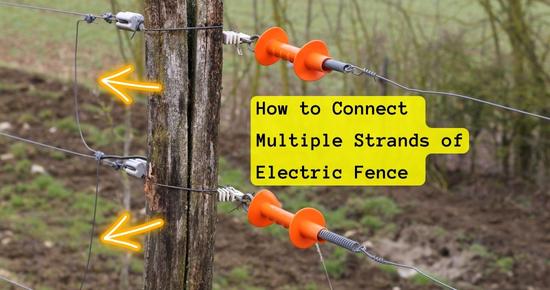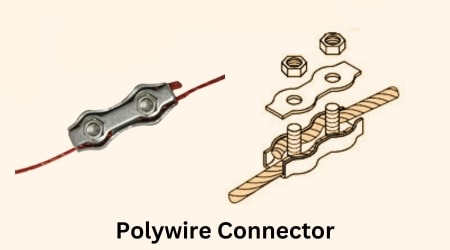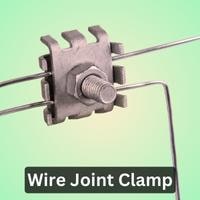The main goal of connecting fence strands is to improve current conductivity in the whole fence. If the fence strands are connected, the current will have several paths to travel in the entire fence. It’ll help reduce resistance and improves current conductivity; thus, this approach is helpful, especially when covering large areas.
While installing parallel fence wires, you’ll most necessarily need to connect fence strands. As all fence strands are separately installed and then connected.
To connect fence strands, we need pieces of wire that’ll act as a jumper between fence strands. Then we’ll tie the jumper wire to the fence strands making a knot or using a fence wire connector.
To tie fence strands, our main goal is to choose a quality wire and a method/tool that fits well in your fencing project(wires) and is cost-effective.
Let’s discuss how to connect multiple fence strands in detail:
How to connect multiple strands of electric fence?
We’ll need a high-quality wire to connect multiple strands of an electric fence. This jumper wire must be the same conductor as the fence wire(strands). However, more thicker wire will be better.
After you have got connecting wires(jumper), we’ll attach the jumper wire to the fence strands. You can either directly knot(tie) the jumper wire to the fence strands or use a fence wire connector.
The most cost-effective & commonly used DIY method to connect the fence strands is by directly tying(knot) the jumper wire to the fence strands.
While if you want to professionally connect fence strands there are several options of fence wire connectors, such as split bolts, open-end crimp sleeves(open-end tap), polywire/poly tape connectors, and wire joint clamps. Choose the connector according to the fence wire type.
Start by tying one end of the jumper cable to the top or bottom fence strand. Then connect the second strands and so on.
You can connect all fence wires with the same wire. But for a strong electrical connection, only connect two. Ensure that the joint is turdy jumper wire is not loose or touching anything except fence strands.
At last, make sure that the jumper wire and fence strands must be tightly connected to each other. A loose connection results in power loss or an ineffective joint.
Tips:
- At a time, you can connect as many fence strands as you want.
Step 1: Choose the right jumper/connecting wire:
Use a jumper wire made of the same conductor as the fence wires. However, thicker and more conductive is better.
Using different conductor wires in your fence may affect the current conductivity as different metals have different electric properties. For example, you can’t connect steel fence strands with mixed metal jumper wires.
You should use a high-quality, sturdy metal wire as a jumper cable to connect metal fence strands.
While if you’ve installed a polywire electric fence, you can use poly wire/rope o connect fence strands. However, choose a thicker poly wire/rope than the fence strands to improve power circulation in your fence.
You can also use standard battery jumper cables for a couple of connections in the fence strands. However, if you’ve to connect fence strands at multiple points, it’ll increase your budget.
Below we’ve discussed methods and tools(connectors) to join fence strands.
Method 1: Knot the jumper wire to the fence strands
The easiest way to connect fence strands is by simply tying(knot) the jumper wire to the fence strands.
For metal fence strands:
If you’ve installed metal or high tensile fence, it’ll be okay to just tightly twist(wind) the jumper/connecting wire on the fence strand.
However, it’s better to knot the jumper wire to the fence strands instead of just winding it. After making a knot, wind/twist the extra wire around the fence.
To ensure a reliable connection between the fence strands and connector wire, press the knot/twists with a plier.
A single loose connection can massively increase the resistance, resulting in voltage drop and poor current conductivity.
Ensure the sturdiness of the joint/knot by trying to move it back and forth. If the connection is loose, it’ll result in poor current conductivity.
Polywire:
If you use a polywire as a jumper wire, burn the ends to expose the metal filaments. It’ll ensure better connection in the conductors and improve current conductivity.
However, you can’t just wind/twist the jumper polywire on the fence strands. For better current conductivity, knot the bare filaments to the fence wires.
Method 2: Using Split bolt:
A split bolt is the most useful tool(connector) to connect metal fence strands professionally. In addition to connecting fence strands, split bolts can also be used to terminate and splice(join) fence wires.
They are usually made of copper, bronze, aluminum, or highly conductive mixed alloys.
There is a cut in the split bolt’s body(thread) where the fence strand and jumper wire are placed. The nut is screwed to make the joint tight.
Split bolts are highly conductive, galvanized to prevent corrosion/rusting, and can be unscrewed for later use.
How to use split bolt connectors?
- First of all, unscrew the nut on the split bolt.
- Place the split bolt over the fence strand. Then, insert the connecting wire/jumper into the split bolt.
- Now slide a washer on the split bolt’s threads.
- At last, hold the split bolt’s head with one wrench and tighten the nut with a second wrench.
- In the same way, connect the other end of the jumper cable to the second fence strands using a split bolt.
Method 3: Open tap crimp sleeves: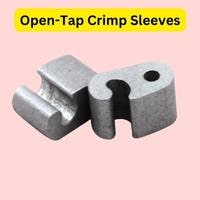
Open-end tap or open-tap crimp sleeves is another useful & less costly tool for connecting metal fence strands. An open-end crimp usually costs 20-30 cents(100 pieces pack is usually around 25-30$).
Buy highly conductive, galvanized, and sturdy open crimp sleeves for a long-lasting joint according to the fence strand’s gauge & hardness.
Remember that open tap crimp sleeves can only connect the jumper wire to the fence wire. You can’t splice fence wires using open-end crimp sleeves because they aren’t ideal for bearing fence weight and tension.
Steps to install:
- Pass the jumper wire’s end through the hole in the open-end crimp sleeve.
- Place the crimp sleeve’s hook(half hole) over the fence strand. Hold everything tightly so it doesn’t slips.
- Take a crimping tool and place the sleeve vertically inside the crimping tool’s jaws.
- Forcefully press the crimping tool’s handle.
- The open-end tap(sleeve) will be pressed, and the wire insides will be fastened together.
- Similarly, take another crimp sleeve, insert the jumper wire’s end through the hole and place the sleeve’s hook over the fence strand(wire), and compress it using a crimping tool.
Tip: Use more than one open-end tap sleeve for a secure & sturdy connection, especially when connecting hard metal fence strands.
Method 4: Polywire connectors:
Poly wire or twine connectors are commonly used to connect poly wire/rope fence strands and splice(join) poly wires. They are usually made of galvanized steel, which is sturdy as well as highly conductive.
Steps to connect fence strands with polywire connector:
- Take a piece of polywire or any highly-conductive wire(to connect strands).
- Unscrew the nuts at the bottom of the polywire connector. The plate inside the connector will get loose.
- Now adjust the polywire fence strands under the connector’s plate. Then insert the end of the jumper(connecting) wire under the plate.
- At last, tightly screw the nut as much as possible using a wrench. This way, the connector wire(jumper) will be tied to the fence strand.
- Similarly, unscrew another polywire connector and place the second fence strand and the other end of the jumper wire under the connector’s plate. Then screw the nut tight.
To use a polywire as a jumper wire, burn it’s both ends with a lighter. Plastic will burn, exposing the metal filaments. Then if you knot the filaments to another wire or use a connector, current conductivity will be improved.
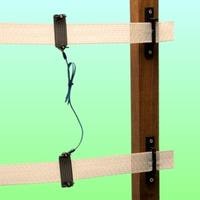 Polytape connectors are also available in the market, used to connect poly tape fence strands. Polytape connectors are made of two metal plates connected with an insulated wire.
Polytape connectors are also available in the market, used to connect poly tape fence strands. Polytape connectors are made of two metal plates connected with an insulated wire.
You have to unscrew both connector’s plates(body), place the poly tape strands inside the connector and tighten the screws on the connector.
Wire joint clamp(claw):
Claw joint clamps connect multiple fence strands coming from different directions. They are usually made of UV-resistant brass or iron. Wire joint clamp pieces range between 30-50 cents per piece.
How to install a wire joint clamp?
- Unscrew the nut and remove the upper cover(jaw).
- Place the fence wire and the jumper wire’s end at the sides of the bolt.
- Place the upper claw(plate) back and screw(tighten) the nut using a wrench.
Conclusion:
To ensure better current conductivity in the entire fence, we must connect all the strands together at multiple locations, especially when covering large areas.
Use a jumper wire that is the same quality as the fence wires. However, it’s better to use a more conducive & thicker wire.
Ensure the joint between the fence strand and jumper wire is secure(well-connected). Otherwise, a loose connection will hinder current flow in the fence.
If you still need any assistance, ask us in the comments below.

